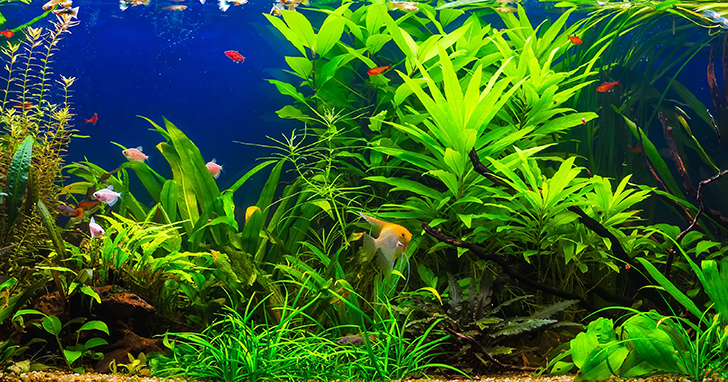Are Live Plants for Your Aquarium?

Why are live plants important for your aquarium?
If you’re planning to keep a gorgeous and flourishing freshwater aquarium, chances are that you’ll be looking at a planted aquarium at some point or the other. While some aquarists decide on having artificial plants due to the fear that live plants might be difficult to maintain, don’t let that throw you off. Plants add a ridiculous amount of value to your aquarium, from providing oxygen to filtration to absorbing carbon dioxide, to name a few. Featuring live plants in your aquarium not only makes it more attractive, but also provides your aquarium’s inhabitants with a healthy environment in which to live. Live plants provide your fish a natural food source with the ability to replenish. What benefits do live plants provide for an aquarium?
By far the biggest benefit that live plants provide for your aquarium is that they produce oxygen (O2) and absorb the carbon dioxide (CO2) and ammonia (NH3) that your fish produce. Adding live plants in your aquarium helps recreate a natural ecosystem in a smaller form and is considered to be one of the most beneficial ways to keep your fish healthy. Plants provide shelter and security for the fish. Because they compete with algae for nutrients, they can help to reduce algae growth. Live plants enhance the appearance and provide a much more natural environment for the fish. By improving water quality and reducing stress, live plants are a great way to improve your fishes' health. Adding live plants, however, does not reduce the need for water changes. When selecting live plants, make sure that you select species that are true aquatic species and that are suitable for your specific water type and fish species. What are good live plants for beginner aquarists?
When first adding live plants to your aquarium, it is wise to choose a large amount of hardy plants such as Anubias, Amazon Sword, Java Moss, Hornwort, and Java Ferns, to name a few.. As you gain more confidence and experience, you can start including the more sensitive plant species. Plant Selection & Placement Tips:
What are good tips for aquascaping?
Caring for your maturing planted aquarium is both an art and a science. With the right technique and a creative eye, you too can enjoy the rewards of a beautifully sculpted garden. Here are some tips:
Regular pruning of tall background plants and the thinning out of mid- and foreground plants will provide your aquarium with a defined and clean composition. It's the hobbyist's pleasure to watch nature grow wild in this small world we tend to, always pruning, shaping, clipping, and replanting for new roots to take hold. Other factors that ensure your plant aquarium is the healthiest you can achieve include:
|
|
|




